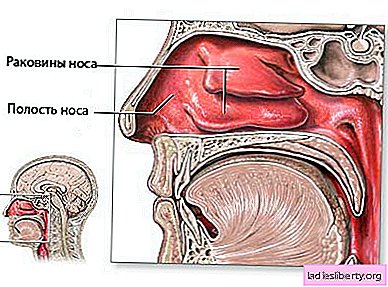
It seems to many that there is no need to spend time treating such a common cold. Indeed, you must admit that every modern person has to endure this common ailment several times a year. However, today there is no doubt the close relationship of the nose with many vital organs: heart, lungs, etc.
Runny nose or rhinitis is one of the most common diseases, which can be either an independent process or a “bell” to various infectious diseases.
General information, causes and symptoms of rhinitis
Rhinitis is a fairly extensive group of diseases that are characterized by symptoms such as difficulty in nasal breathing, decreased sensitivity to smell, various discharge from the nose, etc. Also, with rhinitis, patients are often concerned about burning and itching in the sinuses, drowsiness, fatigue, headaches, unpleasant odor, accumulation of thick secretions in the nasopharynx, poor sleep quality, snoring, etc.
Causes and risk factors for rhinitis:
1. Catarrhal rhinitis - the main factors in the development of this disease include frequent viral infections, high air pollution, bacterial contamination of the mucosa, decreased immunity;
2. Allergic rhinitis - usually manifests itself seasonally. The allergic form of rhinitis is often combined with allergic conjunctivitis, bronchial asthma, urticaria, etc. A frequent consequence of this disease is hypertrophy of the sinuses and the development of polyps.
3. Vasomotor rhinitis - often found in patients with neurocirculatory disorders, in patients with astheno-vegetative syndrome, in hypotensive patients, with endocrine disorders, etc.
4. Drug rhinitis - develops against the background of uncontrolled intake of certain medications: tranquilizers, alcohol, antipsychotics, vasoconstrictive sprays and drops for the nose.
5. Atrophic rhinitis - such a disease, as a rule, is provoked by iron deficiency conditions, lack of vitamins, specifics of work, genetic factors, as well as a result of surgical intervention in the structure of the nose.
In acute rhinitis, symptoms proceed in several stages:
1. Dry stage - accompanied by a feeling of tension and dryness in the nose, swelling of the mucous membrane and nasal congestion;
2. The wet stage - the feeling of congestion increases, nasal breathing is difficult, mucous discharge from the sinuses is observed;
3. Stage of suppuration - swelling decreases, there is an improvement in breathing, nasal secretions become purulent-mucous. As a rule, after 7-10 days, recovery occurs.
In the chronic form of rhinitis, the following characteristic symptoms are observed:
1. Catarrhal rhinitis - moderate secretion of mucus from the nose, decreased smell and difficulty breathing;
2. Allergic rhinitis - tickling and itching in the nose, watery clear discharge, sneezing, redness of the skin around the nose, lacrimation;
3. Atrophic rhinitis - a feeling of dryness, a feeling of unpleasant odor, a large number of dry crusts;
4. Vasomotor rhinitis - usually associated with diseases of the nervous system and is accompanied by alternating nasal congestion and mucous secretions;
5. Hypertrophic rhinitis - this form develops as a result of hypertrophy of soft tissues in the nasal cavity. Accompanied by respiratory failure through the nose;
6. Drug rhinitis - caused by dependence on drugs that were used in the treatment of acute rhinitis;
Diagnosis and prevention of rhinitis
Rhinitis, as a rule, is diagnosed on the basis of all the above symptoms, but in each case it is necessary to strictly differentiate a common ailment from specific diseases, which are, in fact, symptoms of various infections - diphtheria, influenza, scarlet fever, gonorrhea, whooping cough, syphilis, etc.
Each of these diseases has its own individual clinical picture. Examination of the nasal cavity, the study of ENT organs reveal one form or another of rhinitis. In case of complications, special examinations are usually prescribed: consultations with an ophthalmologist, pulmonologist, infectious disease specialist, allergist, as well as various instrumental examinations of the larynx, ear, and pharynx.
Rhinitis Prevention
Prevention of rhinitis is a general hardening to overheating, cooling, dryness and humidity. Also, excellent protection against rhinitis is cleanliness in work and residential premises, maintaining optimal humidity and temperature.
Rhinitis treatment
If rhinitis manifested itself against the background of an infectious infection, which is accompanied by an increase in temperature, then, first of all, strict bed rest should be observed. With hyperthermia, hot foot baths should not be used, since there is a high risk of complications. At subfebrile body temperature, applying heat to the legs makes breathing much easier and helps reduce hypoxia. Vasoconstrictive sprays and nasal drops are also prescribed.
For faster and longer-acting drugs, it is better to use turundas with a vasoconstrictor. Although it is worth noting that prolonged use of such drugs can lead to the opposite result: allergization, swelling of the mucous membrane.
But the most important thing in rhinitis is that it will learn to properly and efficiently blow its nose so as not to provoke the development of various complications - eustacheitis, otitis media, etc. It is necessary to blow out the mucous contents from the nose with a half-open mouth without much effort, alternately clearing the left or right nostril.
To reduce intoxication, it is necessary to take a warm, plentiful drink - tea with raspberries or lemon, milk with a teaspoon of honey, etc. If the patient has an increase in temperature, then antipyretic drugs can be used. Although it is worth considering that analgin, aspirin, etc. can provoke various unpleasant complications and slow recovery, reducing the body's resistance to infection. In especially severe cases, specialists prescribe antibacterial drugs.
Comments











